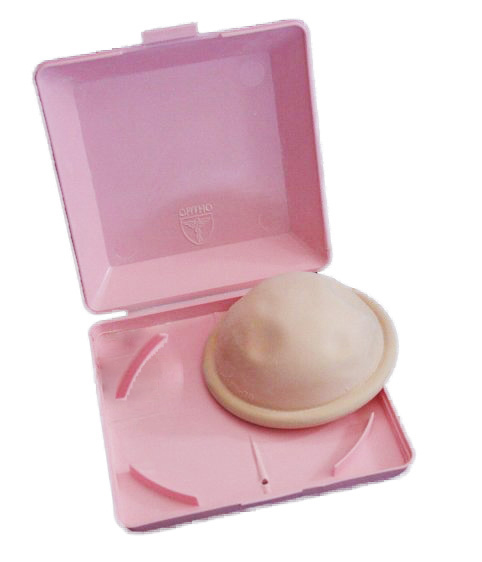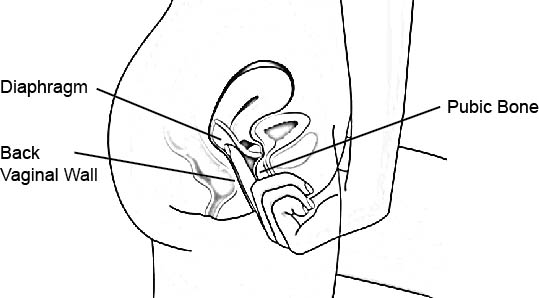
A diaphragm is a barrier method of birth control that is put in the vagina prior to having sex. It covers the opening of the uterus (cervix) and stops sperm from entering the uterus. It is disc-shaped with a flexible rim and can be made of latex, silicone, or nylon.
There are two types:
- A
fitted diaphragm is available by prescription from a healthcare provider.
- A
one size diaphragm (FemCap®, Caya SILCS®) is available without a prescription at some pharmacies.
A diaphragm is intended to be used with a contraceptive gel, either nonoxynol-9 spermicidal gel or an acid buffering gel.
Nonoxynol-9 spermicidal gel/jelly is the most effective kind of contraceptive gel. It:
- prevents pregnancy by killing sperm.
- is no longer made in Canada so it can be hard to find. Some people order it online or pick it up while travelling internationally.
- can cause genital irritation.
- is not recommended for people who are at high risk of getting HIV.
Lactic acid buffering gel can be used if you can’t get nonoxynol-9 spermicidal gel. It:
- is also called a barrier gel (like Contragel® or Caya Gel®).
- helps to seal the diaphragm around the cervix and lowers pH of vaginal fluid to slow down sperm.
- may be less effective at preventing pregnancy than spermicidal gel, but may cause less genital irritation.
How well does a diaphragm work?
- With typical use (not following the exact directions) a fitted diaphragm with spermicidal gel is 84% effective.
- With perfect use (following the exact directions all the time) a fitted diaphragm with spermicidal gel is 94% effective.
- Using a diaphragm with an acid buffering gel may be less effective at preventing pregnancy than using a diaphragm with spermicidal gel. The exact effectiveness is unknown.
- One size diaphragms are likely as good at preventing pregnancy as fitted diaphragms, but the exact effectiveness is unknown.
- Diaphragms don’t protect you from sexually transmitted infections (STIs) or HIV.
How do I use a diaphragm?
When you buy a diaphragm, always read and follow the enclosed manufacturer’s directions.
You need to use a contraceptive gel – either a spermicidal gel or an acid buffering gel - with a diaphragm.
Fitted diaphragms come in different sizes. You need to get refitted for a new diaphragm:
- after you have a baby
- if you gain or lose more than 10 lbs. (4.5 kg)
- after pelvic surgery
- as per
manufacturers' recommendations
Inserting your diaphragm
- Check diaphragm for holes, cracks, and tears by holding it up to the light. Check the expiry on the gel.
- Empty your bladder
before you put your diaphragm in to prevent a bladder infection.
- Wash your hands with soap and water for at least 20 seconds.
- Put spermicidal or acid buffering gel inside the diaphragm. The gel needs to be on the side of the diaphragm that will be right next to the cervix.
- Put your diaphragm in up to 2 hours
before you have sex.
- Lie down, squat, or raise one leg on a chair or toilet.
- Squeeze the rim together and push the diaphragm into the vagina,
along the back vaginal wall as far as it will go.
- When the diaphragm is most of the way in, let go of it and tuck the front edge of the diaphragm up behind the pubic bone.
- Make sure you can
find your cervix (it feels like the tip of your nose) through the diaphragm.
- If your diaphragm is in the right place you should not feel it. If it isn’t comfortable, it’s likely not in the right place. Take it out and try again.

Use an applicator to add extra gel into
your vagina each time you have sex or if it’s been more than 2 hours since gel was put in.
Do not remove the diaphragm to do this.
Taking out your diaphragm
- It must stay in for at least
6 hours after
the last ejaculation into the vagina.
- Wash your hands with soap and water for at least 20 seconds.
- Hook your finger under the rim and pull the diaphragm down and out gently to avoid damaging it.
- Don’t keep your diaphragm in for more than
24 hours.
Caring for your diaphragm
- Wash your diaphragm after each use with mild, unscented soap and warm water. Rinse and dry it completely.
- Store it in a cool, dry place.
- Replace your diaphragm
according to manufacturer’s instructions (usually every 1-2 years) or sooner if you notice any damage.
- Water-based lubricants and contraceptive gels are safe with any diaphragm. Oil-based products can damage latex diaphragms.
What are the benefits of a diaphragm?
- The diaphragm doesn’t have hormones. There is no effect on a person’s natural hormones.
- It can be used by people who are breast/chest feeding.
- It can be combined with other methods of birth control (like external condoms).
- A diaphragm is reusable.
What are the disadvantages of a diaphragm?
- Some people could have an allergy to latex, silicone, or spermicide.
- Using a diaphragm might increase your risk of a bladder infection.
- It can move out of place during sex. If this happens it
may not protect you from
pregnancy.
- There is a slightly higher risk for toxic shock syndrome, especially if the diaphragm is left in for more than 24 hours.
- Diaphragms need to be used correctly to prevent pregnancy. Consider using emergency contraception if it wasn't used the right way or if it moved out of place during sex.
What else is important to know about consent, sexual activity, and birth control?
- You have the right to decide to have sex or not. Talk with your partner or partners about consent.
- There’s an 85% chance of becoming pregnant within one year, if no birth control is used for vaginal sex.
- Use a condom or barrier every time you have sex (oral, vaginal, anal). Condoms help prevent pregnancy, STIs, and HIV.
- You can lower your risk of HIV by taking an HIV prevention pill every day. Many Albertans can get it for free. Visit
HIV PrEP to find out more.
- Transgender and gender diverse people who have a uterus can use hormonal birth control. It can help prevent pregnancy and make periods lighter and less painful.
Where can I find more information?
If you have questions, need to find a sexual health clinic near you, or want more information, call Health Link at 811 anytime, day or night, to talk to a registered nurse.
